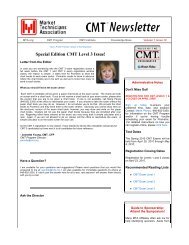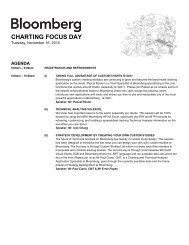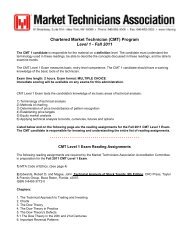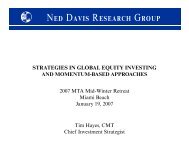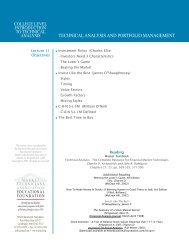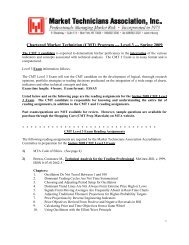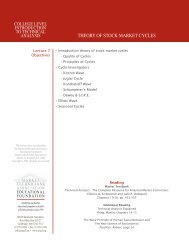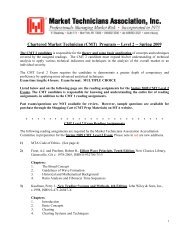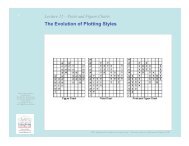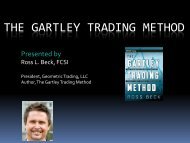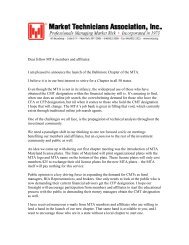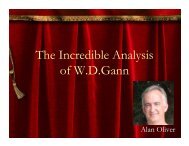Journal of Technical Analysis - Market Technicians Association
Journal of Technical Analysis - Market Technicians Association
Journal of Technical Analysis - Market Technicians Association
Create successful ePaper yourself
Turn your PDF publications into a flip-book with our unique Google optimized e-Paper software.
40<br />
Figure 4 plots a weekly comparative relative strength line 8 from 1990-2006 <strong>of</strong> the %b BW strategy using the S&P 500 Price Index as the base price. We delineate<br />
two major periods <strong>of</strong> relative underperformance.<br />
Figure 4.<br />
Tests <strong>of</strong> Statistical Significance<br />
Is the difference in return between the %b BW strategy and the S&P 500 statistically significant? To answer that question, we used a paired comparisons test <strong>of</strong><br />
4287 paired differences in daily returns from 1990-2006. The sample mean difference was .0533% per day (the mean daily alpha). The sample standard deviation <strong>of</strong><br />
the mean difference was .7462% (the daily tracking error). The standard error <strong>of</strong> the sample mean difference was .7462% * 4287^.5 = .0114%. The calculated test<br />
statistic was z = (.0533/.0115) = 4.68. The two-tailed P value is less than 0.0001. The difference in returns is extremely statistically significant.<br />
Is the risk-adjusted return <strong>of</strong> the %b trading strategy statistically significant? The Information Ratio 8 , also known as the appraisal ratio, is a widely used risk<br />
metric that measures risk and return relative to an appropriate benchmark. The information ratio equals alpha divided by tracking error. We tested to determine if the<br />
information ratio (IR) <strong>of</strong> the %b strategy was greater than zero:<br />
t – statistic = IR • T<br />
Where T is the number <strong>of</strong> years.<br />
From Table 1 we see the information ratio for the %b strategy equaled 1.15. So our test statistic is t = 1.15 * 17^.5 = 4.74 with df =16. The two-tailed P value<br />
equals 0.0003. The difference is extremely statistically significant.<br />
Discussion<br />
The evidence supports our thesis that a rotational trading algorithm using relative %b rankings can select stock portfolios that beat the risk-adjusted return on<br />
the S&P 500. Moreover, those portfolios consist only <strong>of</strong> S&P 500 constituent stocks. For perspective, a search <strong>of</strong> the expansive Morningstar mutual fund database<br />
in February 2007 reveals that just three mutual funds had an annualized rate <strong>of</strong> return in excess <strong>of</strong> 18% over the past fifteen years. None <strong>of</strong> those returns exceeded<br />
19%. The %b BW Strategy* returned 24.1% annualized with surprisingly little risk relative to the benchmark. The charts in Figures 3 and 4 as well as the Sharpe<br />
and Information Ratios reported in Table 1 provide the relevant risk assessment analytics.<br />
*The historical performance <strong>of</strong> a simulated trading strategy is not a guarantee <strong>of</strong> future returns.<br />
Admittedly, we have presented back test results that fly in the face <strong>of</strong> the well-worn trader’s axiom “Cut your losses short; let your pr<strong>of</strong>its run.” Table 2 confirms<br />
that the %b BW system <strong>of</strong>fers no protection against ruinous losses at the asset level. The diversification <strong>of</strong> an equal-weight 40 stock portfolio afford the only down<br />
side protection, a striking demonstration <strong>of</strong> the critical importance <strong>of</strong> position sizing and diversification in system development.<br />
While our results are statistically significant, the economic significance is less straightforward. The system trades frequently averaging over three trades per<br />
day. For taxable investors, returns would be taxed 100% as unfavorable short-term capital gains. From Table 1 we see the average pr<strong>of</strong>it per trade is 1.2% net <strong>of</strong> an<br />
assumed .2% round trip transaction costs. That is likely satisfactory only for a trader using an efficient broker9 and perhaps more importantly, trade size must be<br />
sufficiently small to have only a modest impact on market prices. Assessing potential slippage10 is clearly an important consideration when evaluating any system.<br />
Finally, the results suggest that investors overreact, possibly to news or changing prices, in a three-month (65- trading day) frame <strong>of</strong> reference. By design, our<br />
indicator look-back period corresponds with the three-month earnings report cycle for stocks as well as the performance reporting cycle for many asset managers<br />
capturing possible earnings-announcement and window dressing11 effects.<br />
Jo u r n a l <strong>of</strong> <strong>Technical</strong> <strong>Analysis</strong> • 2008 • Issue 65



